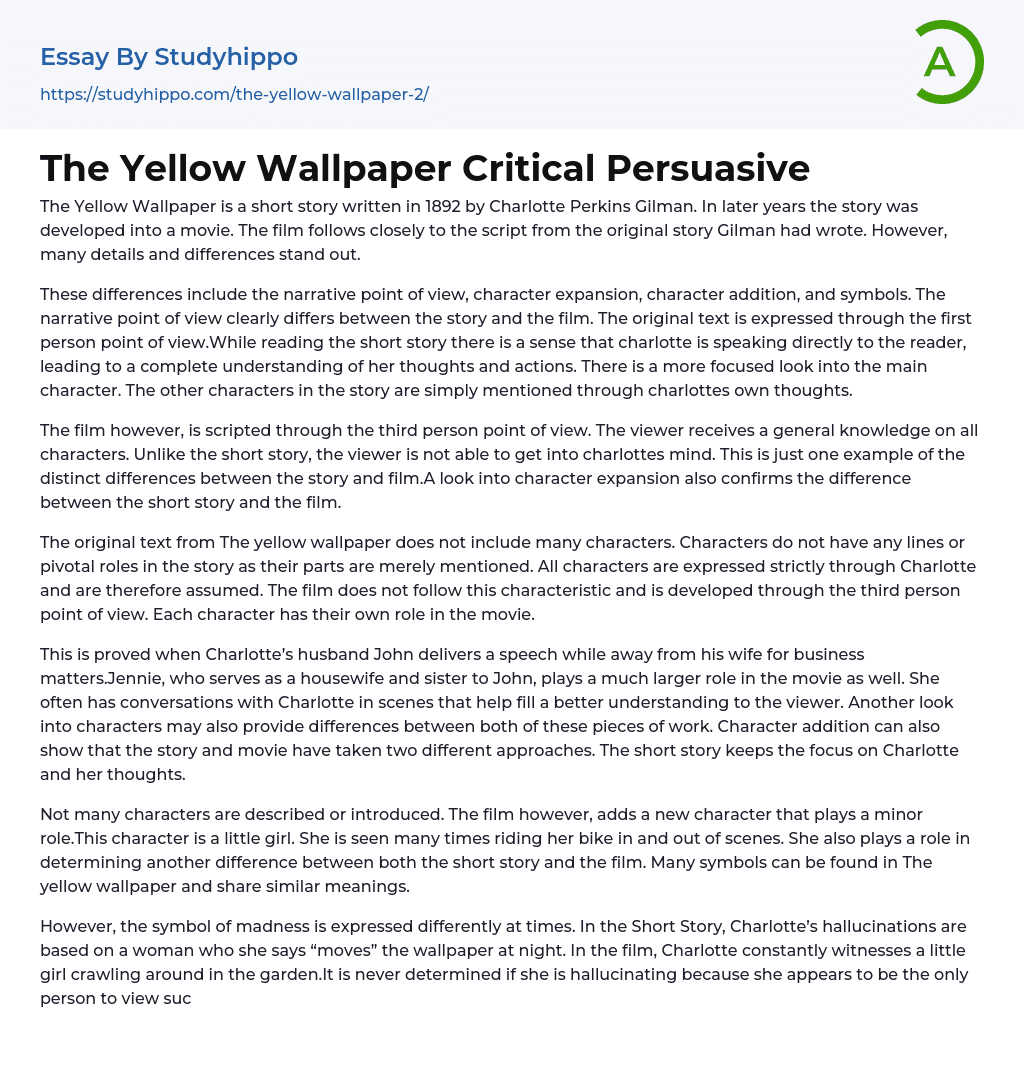Charlotte Perkins Gilman wrote The Yellow Wallpaper in 1892, which was later adapted into a movie. Although the film closely follows Gilman's original script, there are numerous details and differences that distinguish it.
The discrepancies between the narrative standpoint, character elaboration and introduction, and symbols set the short story and film apart. In the short story, the use of first-person point of view provides a sense that Charlotte is addressing the reader directly, enabling a comprehensive comprehension of her ideas and activities. The central character is examined more intently than in the film, and the other characters are only referred to through Charlotte's reflections.
Although the film is written in third person perspective, it provides the audience with overall information about all characters. In contrast to the short story, the viewer cannot delve into Charlotte's thoughts. Therefo
...re, the distinct disparities between the two mediums are apparent. Moreover, examining character growth further highlights the divergence between the short story and the film.
In the original "The Yellow Wallpaper," there are few characters and they do not have significant roles or lines. They are conveyed solely through Charlotte's perspective. However, the film differs as it employs a third person point of view and gives each character a distinct role.
While away on a business trip, Charlotte's husband John gives a speech that confirms the story. The movie showcases Jennie, who is not only John's sister but also a homemaker, in more prominent scenes that help viewers comprehend the narrative better. Additionally, differences between the film and the original tale can be emphasized by introducing new characters. Nevertheless, the short story remains centered on Charlotte and her perspectives.
While the story
introduces only a few characters, the film features a minor character in the form of a little girl who is frequently shown riding her bicycle throughout various scenes. This character serves to distinguish the short story from the film. Furthermore, The Yellow Wallpaper incorporates multiple symbols that have similar meanings.
Although both the Short Story and the film feature the symbol of madness, they portray it differently. In the Short Story, Charlotte's hallucinations revolve around a woman whom she believes moves the wallpaper at night. Conversely, in the film, Charlotte often witnesses a little girl crawling around in the garden, but it is unclear if she is hallucinating since nobody else observes such behavior. Despite conveying an identical message, each medium portrays the idea through distinct symbols. The significant evidence available underscores that there are substantial distinctions between the short story and the film.
The narrative point of view highlights contrasts between the two versions, despite their overall similarity. Additionally, differences in character expansion, character addition, and symbol development methods support this claim.
- Book Summary essays
- Metaphor essays
- Reader essays
- Rhyme essays
- Literary devices essays
- Villain essays
- Books essays
- Genre essays
- Literary Criticism essays
- Writer essays
- Protagonist essays
- Simile essays
- Poem essays
- Book Report essays
- Book Review essays
- Greek Mythology essays
- Plot essays
- Tragic Hero essays
- Coming of Age essays
- Play essays
- Rhetoric essays
- Rhetorical Question essays
- Translation essays
- Understanding essays
- Reason essays
- Character essays
- Letter essays
- American Literature essays
- Literature Review essays
- Utopia essays
- Poetry Analysis essays
- Dante's Inferno essays
- Between The World and Me essays
- Incidents in The Life of a Slave Girl essays
- Flowers for Algernon essays
- Myth essays
- Everyday Use essays
- Boo Radley essays
- Genesis essays
- Richard iii essays
- Alice in Wonderland essays
- On the road essays
- Ozymandias essays
- The Nightingale essays
- Holden Caulfield essays
- Animal Farm essays
- 1984 essays
- A Hanging essays
- Shooting An Elephant essays
- A Tale Of Two Cities essays




